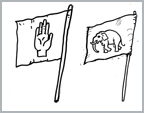|
observer |
|
|
|
|
|
OTHER LINKS |

|

|

|
Politics of the mainstream
The party that came into its own
The reactionaries, it seemed, had to be fought from within the clammy
confines of the Walauwwa Istoppuwa. When C. P. de Silva sought to storm the same barricades, and bring down the SLFP aristocracy, he wet into a free fall — from which he never quite recovered. Others who appeared to make some tentative bids at overcoming the feudal family dominance within the SLFP, were near moribund forces when they led their campaigns. The late Hector Kobbekaduwa was the best example. But even as a family party, the SLFP hugged the left, and it was in the interests of the family dynasty to do so. It saw its sustenance in empowering the politics of the left of centre. This was a novel amalgam —- a dynasty serving as the wellspring of
progressive working class politics in the country. The United National Party (see related story..) has abdicated its role as the party of the right wining, due primarily to its un-electability, and due secondarily to its exceeding its right wing brief. But triangulation apart, the SLFP has tried to live down its image as the party of the Sinhalese. This was not always the case. The minorities in the peninsula and the islanders around the peninsula swore by the SLFP. The first Sri Lankan official killed by the LTTE was Alfred Durriaipah, the SLFP mayor. Today, the SLFP is regaining the lost minority in a tentative way. Just before the 55th anniversary celebration, the SLFP secured the support of two mainstream Tamil parties. It seems things have come a full circle. The SLFP found its identity as a party of the progressives led by the progressives, as opposed to the aristocracy. Now, all it has to do is to be more accommodating to the minorities in a way that suits the party’s ‘new Sri Lanka’ plank. The party that seeks to come into its own...The UNP spends its 60th year as a party that was almost cheated of the centre stage. It leadership was decimated in the violent politics of the day. Athulathmudali, Gamini Dissanayake, Premadasa — the names are a list that writes the epitaph for the UNP’s historical dominance. Its contagion, however, has not been death. It has been the lack of a grasp of change. Its leadership has been detached from latter day reality to the point of being anachronistic. It’s an unenviable situation to be in, for a party that seemed invincible more than just a decade back. It’s a terrible situation to be in, for such a party.But, this was not the UNP’s history. It was a green party - - it was even a poor man’s party, and it was identified once upon a time as the party that provided rice for the poorest, and water for the greenest of green revolutions. All its ties to aristocracy and the deracinated upper crust were forgiven, for the mere fact that it was the United National Party that made the connection between the peasant, the Wewa and the Dagoba. The left and the progressive among us may have dismissed this as a lumpen reaction to the patronage politics of the ruling aristocracy - - and to a great extent they were right. But the voter didn’t think on these same lines. Having written that, it’s a fact that Dudley Senanayake’s UNP was not the same as J. R. Jayewardene’s UNP or Premadasa’s UNP. Pursuing economic growth, Jayewardene alienated many true progressive leftists in the country almost totally from the party that evoked home and hearth, rice paddies, the village and the temple. It’s the UNP’s almost total push to the right, which caused the almost desperate push for the middle ground from the core of the Sinhala polity. The story adjacent —- the story of the SLFP — got written partly because the story of the UNP went dangerously into the extreme. But the UNP might regain itself. It’s positioned at the threshold almost of joining a national endeavour. Or so we hear. |









